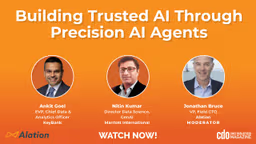Branded Content
True Hybrid Cloud Explained — One Platform, Endless Flexibility
Written by: Shayde Christian | Chief Data and Analytics Officer, Cloudera
Updated 11:34 AM UTC, Thu April 17, 2025

You know it, we know it, we all know it: Data is the foundation of every modern business decision. Unfortunately, though, many organizations struggle to manage it effectively. Siloed environments, inconsistent governance, and fragmented infrastructure create inefficiencies that slow innovation and increase costs. While hybrid cloud has been positioned as a solution for some time now, many implementations fall short, lacking seamless data integration and leaving organizations with the same challenges they were trying to solve.
This is where a true hybrid cloud infrastructure comes in. Unlike traditional hybrid setups, a true hybrid approach enables organizations to move not only data but also workloads effortlessly across on-premises and cloud environments while maintaining consistent security, governance, and performance. There are several key factors to determine if a hybrid cloud approach meets the criteria of true hybrid. One of the most significant differentiators is the ability to support all infrastructures — across the data center, cloud, and at the edge — on a single platform while providing identical, portable functionality across all environments. It’s the gold standard of hybrid infrastructure.
Let’s explore how a true hybrid cloud enables organizations to bring analytics to their data without the need for refactoring, improve data management across environments, and future-proof their infrastructure for emerging technologies.
Breaking down silos with true hybrid approaches
Traditional hybrid cloud environments typically allow organizations to analyze data across multiple deployments, such as cloud, on-premises, or edge. However, they often lack the consistency and integration needed for true workload portability. This results in fragmented governance, inconsistent security controls, and increased complexity when moving or managing data across infrastructures.
A true hybrid model solves these challenges by ensuring that data is treated consistently, regardless of where it resides. With unified governance and security policies applied across all environments, organizations gain the confidence that their data will remain compliant, protected, and accessible, even as it moves between infrastructures.
True hybrid also enables end-to-end support for the full data lifecycle, from ingestion and transformation to warehousing, advanced analytics, and more. This consistency allows workloads to run seamlessly across different infrastructures without the need for refactoring. It delivers the flexibility organizations need without adding technical debt (and we all remember the pain of those first-generation cloud migrations).
Moreover, true hybrid simplifies data management by consolidating services across environments, reducing the need to maintain and coordinate multiple siloed data platforms. This unified architecture streamlines workflows and automates processes that would otherwise require custom integrations or redundant tools. For organizations using Cloudera, it means teams can apply their expertise in one environment — on-prem or in the cloud — and easily transfer those skills to another. This reduces operational complexity, minimizes the need for specialized personnel, and accelerates the path to insight and value.
What true hybrid means for AI and emerging technologies
A true hybrid approach provides two key benefits to the enterprise: freedom and flexibility. A true hybrid approach enables organizations to quickly adapt to emerging technologies and the changing nature of business, ensuring they are always prepared for the future. Whether dealing with AI or other innovations, each new technology presents unique demands.
With a true hybrid model, organizations can move AI to where it will generate the most value, rather than pulling data from its storage locations and moving it to where it can be used. It enables users to be able to pick the best tool (infrastructure and workflow) for the best job. This preserves data security and compliance with internal policies and governance guidelines, regardless of technological advancements.
This flexibility allows organizations to bypass the need for rearchitecting environments when migrating from on-premises infrastructure to the cloud, speeding up migration and reducing costs. In a true hybrid setup, organizations can distribute tasks and needs where they are best placed across multiple infrastructures, ensuring they remain adaptable and ready for future shifts.
Leveraging true hybrid in the real world
Let’s explore how a true hybrid approach plays out in real-world scenarios:
First, accelerating cloud migration becomes significantly easier with a true hybrid data platform. Traditional migrations often require rearchitecting applications because the deployment models available on-prem may not match what’s available in the cloud — for example, moving from traditional clusters to cloud-native analytics. True hybrid removes this barrier by supporting both traditional and modern analytics architectures across on-premises and cloud environments. This enables data teams to take a flexible, phased approach: they can modernize workloads on-prem before migrating, lift and shift existing deployments to the cloud without changes, or adopt a mix of both strategies based on business needs. This flexibility reduces complexity, shortens migration timelines, and allows organizations to modernize at their own pace.
Second, adaptive use case deployment allows organizations to run workloads dynamically based on resource optimization — whether that means maximizing performance, ensuring high availability, reducing costs, or meeting data sovereignty requirements.
For example, a workload might run in the cloud to take advantage of scalable compute resources during peak demand, then shift on-prem for compliance or latency-sensitive tasks. AI and ML-powered applications can adjust in real time to changing data, infrastructure conditions, or business priorities, ensuring they deliver the most relevant outcomes without unnecessary complexity or compromise to security and governance.
Finally, continuous optimal deployment ensures that workloads always run at peak performance and cost-effectively while keeping the architecture future-proof. Unlike traditional hybrid models that often lock organizations into a single infrastructure, true hybrid allows teams to shift workloads across different environments as needed. Whether on-premises or in the cloud, teams can deploy workloads wherever they make the most sense — without compromising security, compliance, or performance.
A true hybrid cloud takes everything one step further, it’s not just about bridging infrastructure, it’s about creating a seamless, flexible, and future-proof foundation for data and workloads. To learn more about true hybrid infrastructure, read Cloudera’s latest eBook “Achieving True Hybrid: A Comprehensive Roadmap.”
About the Authors
Shayde Christian is Chief Data and Analytics Officer at Cloudera. He guides data-driven cultural change for Cloudera to generate maximum value from data. Christian enables customers to get the absolute best from their Cloudera products such that they can generate high-value use cases for competitive advantage.
Previously a principal consultant, Christian formulated data strategy for Fortune 500 clients and designed, constructed, or turned around failing enterprise information management organizations. He enjoys laughter and is often the cause of it.
Wim Stoop is Senior Director of Product Marketing for Cloudera. In this role, he leads the marketing direction and strategic vision for Cloudera’s mission to let organizations turn data into business value at scale. Prior to Cloudera, Stoop spent more than 17 years helping blue-chip companies such as IBM, BP, and HSBC solve their most data-intensive challenges in the context of their business objectives and usage scenarios.
Stoop is a regular speaker at industry events where organizations are deciding and defining their big data strategy and direction. He holds a degree in Chemical Process Technology from the Eindhoven University of Technology in The Netherlands.






